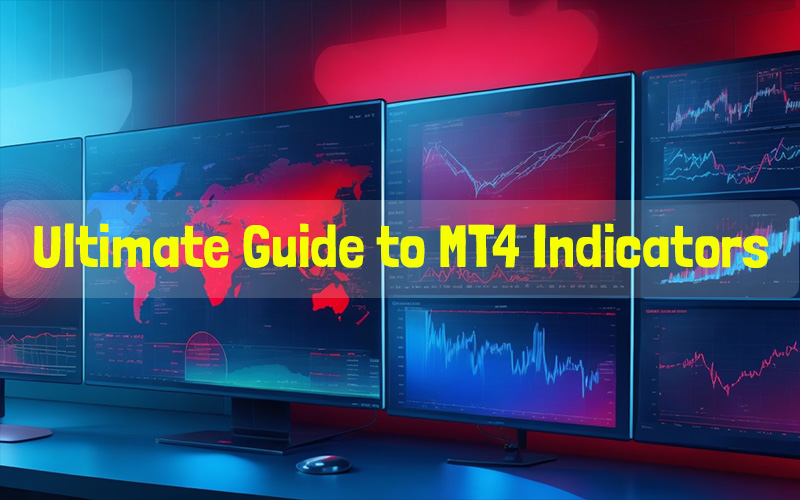Meta traders around the world rely on MT4 indicators to analyze markets and identify potential trading opportunities. MT4 indicators are invaluable tools that can help you enhance your trading strategy. But with hundreds to choose from, finding the right indicators can be challenging.
This comprehensive guide provides everything you need to know about MT4 indicators – how they work, types of indicators, and tips for picking the best ones for your trading style. Read on to become an MT4 indicator expert!
What Are MT4 Indicators?
MT4 indicators are technical analysis tools used on the popular MetaTrader 4 forex trading platform. They analyze price data and market conditions to generate trading signals or highlight patterns and trends.
Indicators apply mathematical formulas and statistical models to historical and real-time price data. The output is displayed visually on the MT4 chart in the form of lines, histograms, shapes or symbols.
The signals and patterns picked up by indicators help traders confirm when to enter, exit or hold onto a trade. MT4 comes equipped with 30+ built-in indicators including moving averages, Bollinger bands, MACD and RSI. You can also install custom indicators designed by other users.
Overall, indicators aim to simplify price information and improve the accuracy of your trades. When used properly, they can give you a valuable edge in the forex market.
Types of MT4 Indicators
There are four main classes of MT4 indicators:

1.Trend Indicators
Trend indicators help determine the overall direction of the current market – whether it’s trending up, down or trading sideways. They generate trading signals and alert you to changes in market trends. Popular examples include moving averages, ADX, MACD and Ichimoku cloud.
2. Momentum Indicators
Momentum indicators measure the speed and strength of price movements. They oscillate above and below a centerline to signal overbought and oversold market conditions. Common momentum indicators are RSI, stochastics, CCI and Williams %R.
3. Volume Indicators
Volume indicators monitor trading activity in the market. They highlight spikes in volume which often precede major price movements.
The two most popular volume indicators are on-balance volume (OBV) and money flow index (MFI).
4. Volatility Indicators
Volatility indicators measure how wildly prices are fluctuating over a period of time. Times of high volatility present trading opportunities for profit.
Bollinger bands, average true range (ATR) and Keltner channels are examples of volatility indicators.
Benefits of Using MT4 Indicators
MT4 indicators offer several advantages that can improve your trading performance:
- Identify Trends and Reversals – Indicators help spot new trends, overbought/oversold conditions and trend reversals – giving you an edge on timely entries and exits.
- Provide Trading Signals – Indicators generate clear trading signals that define market entry and exit points. You don’t have to interpret the market manually.
- Remove Emotions – Indicators offer an objective perspective of the markets. This can help you stick to your trading system without being swayed by emotions.
- Easy to Use – Indicators clearly display data analysis on the MT4 chart. You don’t have to be an expert to understand and use them.
- Versatility – You can use indicators individually or combine them to create a robust trading strategy. Different indicators can be used for confirmation or to analyze specific situations.
- Customizable – MT4 gives you the option to tweak indicator settings to suit your trading style and market conditions. You can experiment to find the best parameters.
- Efficient – Indicators digest complex calculations and analysis into simple signals and visuals. This allows you to make quick, informed trading decisions.
Tips for Picking the Best Indicators
With hundreds of indicators to choose from, deciding which ones to use can be tricky. Here are some tips to pick the best indicators for your trading:
- Match Indicators to Goals – Determine what kind of information you need to improve your trading. Then pick indicators that provide that data.
- Use a Mix of Indicator Types – Combine trend, momentum & volatility indicators for a more well-rounded view of the markets.
- Find Indicators that Complement Each Other – Pick indicators that work together to confirm trading signals and provide better accuracy.
- Choose Indicators with Different Time Frames – Use indicators based on short, medium and long-term time frames to get a multi-dimensional market perspective.
- Test Indicators Thoroughly – Demo test indicators under different market conditions to understand how they perform.
- Start with a Few Indicators – Begin with 2-3 indicators that provide the most useful signals. You can add more later once you are comfortable.
- Read the Source Code – For customizable indicators, read the source code so you understand the logic behind the signals.
Examples of the Best MT4 Indicators
Here are 10 of the most accurate, reliable and versatile MT4 indicators that every trader should know:
1. Moving Average (MA)
Moving averages smooth out price action and help identify the overall market trend. The longer the time period, the more smoothed out the moving average line is.
MAs also provide dynamic support and resistance levels. The 50 & 200 period MAs are most popular. Use a shorter MA (e.g. 20) along with a longer MA (e.g. 50) for trading signals.
2. Relative Strength Index (RSI)
The RSI oscillator indicates overbought and oversold market conditions. It stays between 0 and 100. You can look for reversals when the RSI moves above 70 (overbought) or below 30 (oversold).
Divergence between RSI and price can also predict trend changes. Traders most commonly use 14 periods.
3. Moving Average Convergence Divergence (MACD)
MACD reveals momentum shifts by measuring the relationship between two moving averages. Crossovers of the MACD line and signal line generate clear trading signals.
Zero line crossovers also indicate a market shift. MACD works well for trend and momentum trading strategies. Standard parameters are 12/26/9.
4. Bollinger Bands (BB)
Bollinger bands plot bands around price based on volatility. When price touches the upper or lower band, it often signals a reversal.
BBs contracting around price show declining volatility and highlight potential breakouts. Traders most commonly use 20 periods for the underlying SMA.
5. Average True Range (ATR)
ATR measures volatility in pips – showing the degree of price movement. High ATR indicates greater volatility and potential trading opportunities. You can use ATR stops to set stops based on volatility. 14 periods is standard.
6. On-Balance Volume (OBV)
OBV tracks cumulative buying/selling volume. Rising OBV indicates bullish sentiment, while falling OBV signals bearish sentiment. Look for divergence between OBV and price.
OBV also confirms trend changes – a move above previous highs or lows shows trend confirmation. No inputs required for OBV.
6. Commodity Channel Index (CCI)
CCI identifies cyclical market moves by measuring deviation from the statistical mean. CCI above +100 signals overbought conditions while CCI below -100 is oversold.
Zero crossovers indicate reversals. CCI works well with short and medium-term strategies. Typical input is 20 periods.
7. Parabolic SAR
Parabolic SAR places trailing dotted lines above or below price. The dots flip positions when the trend changes direction.
SAR below price indicates an uptrend, while SAR above shows a downtrend. Traders use SAR to set trailing stops or develop entry/exit strategies.
8. Ichimoku Cloud
Ichimoku cloud uses multiple lines to clearly identify support, resistance and trend. Trading signals are generated from crossovers of the lines and when price crosses in and out of the cloud.
Ichimoku works well for all trading time frames. Standard inputs are 9/26/52.
9. Standard Deviation (STDEV)
Standard deviation bands plot volatility-based bands around a moving average. STDEV expands and contracts based on volatility similar to Bollinger bands.
Price hitting the upper or lower band often signals a reversal. 20 periods is commonly used for the underlying moving average.
Putting It All Together
MT4 indicators are invaluable for analyzing the markets and identifying high-probability trades. However, they should not be relied on exclusively. Here are some tips for using indicators effectively as part of an overall trading plan:
- Combine indicators with other forms of analysis like price action and chart patterns
- Use indicators to confirm – not replace – your own analysis and judgment
- Pick only the most relevant indicators for your trading style and strategy
- Use at least one indicator from the four main types (trend, momentum, volatility, volume)
- Employ indicators on multiple time frames for greater accuracy
- Customize indicator settings and backtest to determine optimal parameters
- Monitor how indicators perform in different market conditions
- Never base trades on indicators alone – incorporate other confluence factors
By integrating the best indicators into your broader trading approach, you can take your forex trading to the next level.
Conclusion
MT4 indicators are invaluable tools – if you know how to use them properly. Follow this guide on types of indicators, benefits, and expert tips for picking the best ones. Indicators can help you identify high-probability setups, remove emotions, and make smarter trading decisions.
However, they should be just one component of your overall trading strategy. Combine indicators with other forms of analysis for optimal results. With the right indicators tailored to your trading style, you can boost your success in the exciting forex market.

